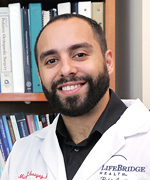Neurofibromatosis
What is neurofibromatosis?
Neurofibromatosis (NF-1) is a genetic disorder that affects musculoskeletal growth and development. It is also known as von Recklinghausen disease.
What causes neurofibromatosis?
Neurofibromatosis is caused by a mutation in a gene called the NF-1 gene on chromosome 17. This gene affects a protein called neurofibromin. Neurofibromin is important in many tissues, including nerves and other musculoskeletal tissues. As a result, the gene mutation causes abnormalities in several tissues.
How common is neurofibromatosis?
Neurofibromatosis is one of the most common genetic disorders, occurring in 1 in 3,000 people. Neurofibromatosis affects both males and females equally. Because of the genetic mutation which caused neurofibromatosis, it often occurs in multiple members of one family. There are other types of neurofibromatosis which are much less common.
How is neurofibromatosis diagnosed?
Neurofibromatosis is diagnosed by observation of multiple clinical findings associated with the condition. Patients with a concern for neurofibromatosis have to display two or more specific findings in order to be diagnosed with it. These findings include:
- six or more colored macules called café-au-lait spots on the skin,
- freckles in the armpit or groin area,
- more than one nerve lesion called a neurofibroma,
- a nerve lesion of the eye called an optic glioma,
- more than two colored spots on the eye called Lisch nodules,
- thinning or bowing of the leg bones, and
- a close relative (parent, sibling, or child) with known neurofibromatosis diagnosis.
Neurofibromatosis may also be diagnosed with a genetic test for the NF-1 gene abnormality. Genetic testing is helping in very young children because the typical findings listed above are not always evident in babies and toddlers.
What are the treatment options for neurofibromatosis?
The genetic abnormality that causes neurofibromatosis cannot be cured; however, there are treatments available for the different body systems that are affected by neurofibromatosis. Typically, skin and eye findings do not require treatment. Nerve tumors sometimes require surgical excision if they are causing symptoms. Nerve tumors and other abnormal growth of the bones of the spine can also cause curves in the spine which may require surgery to correct. Neurofibromatosis is associated with increased risk for different types of cancer, including brain cancer. Therefore, neurofibromatosis patients should be monitored.
Another problem that can occur in growing children with neurofibromatosis is congenital pseudarthrosis of the tibia (CPT). CPT causes a bending and/or breaking of the tibia (shin bone) which does not heal well. This can also affect the smaller bone in the lower leg called the fibula. About 5% of children with neurofibromatosis will develop CPT. While other disorders can cause CPT, 50-75% of children with CPT also have neurofibromatosis. While a bowed leg associated with CPT may be treated with a brace, surgery is usually required to treat the bowed bone deformity, a leg length difference, or a break in the bone that does not heal well on its own. Please see the congenital pseudarthrosis of the tibia condition for full details of how it is treated.
Why choose the International Center for Limb Lengthening for treatment of neurofibromatosis?
Limb Lengthening and deformity correction are complex processes. Your doctor at the International Center for Limb Lengthening will take the time to make sure you understand all of your options and then will customize your treatment to meet your specific needs. Our patients benefit from our team-centered approach with world-renowned surgeons and specialized physician assistants, nurses and physical therapists. We help patients with neurofibromatosis achieve their best possible orthopedic result.


